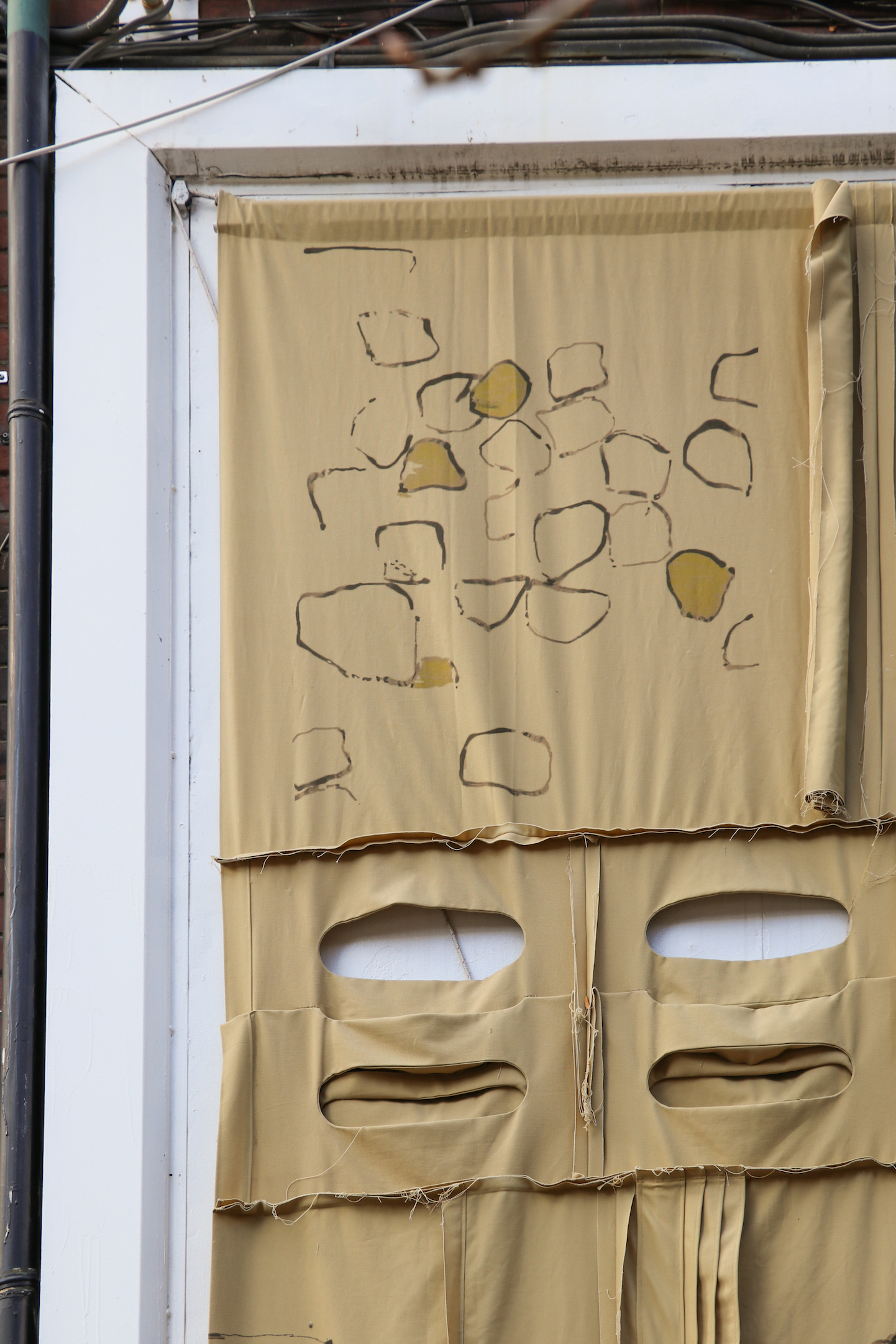SPACE invites one artist to produce a yearlong series of images for a public-facing billboard located on the east façade of Mercer Union.
Mercer Union’s SPACE billboard commission has invited artist Lotus Laurie Kang for its 2022–23 season for a yearlong series titled, Mother Always Has a Mother. Known for her sprawling installations and distinctive material repertoire, Kang’s practice is a dialogue with entropy. Elegantly disordered and richly layered, her site-sensitive works explore the relational bonds between time, personal history, and cultural knowledge. They seek to disrupt a human-centred perspective of the world with a broad curiosity for life and matter tangled in states of exchange that produce and are reproduced by their environments.
Sunlight, Kang’s earliest collaborator, accumulates and rewrites much of the photographic works for which she is best known. While materials like steel, silicone, perishable or manufactured goods assist as other forms of carriers. In Mother Always Has a Mother the artist offers something new, working for the first time with textiles to produce a series of three sculptural works that translate ideas of inheritance, loss, and lineage through the vernacular of seams, frayed edges, and folds. A deconstructed industrial grain bag suggests the pattern from which Kang assembles the works in this series in heavy cloth. Each edition features reproductions of renderings by the artist in photographic chemistry. Conjuring memory of her paternal grandmother, who opened a seed and grain shop in Seoul after fleeing North Korea, the artist contemplates the grain bag as evidence of an accelerated world. Mother Always Has a Mother considers what we carry by revealing the tension between conscious memory and embodied knowledge: one coded in time, the other in flesh; each in continual transformation.
Wheat (2022) is the first edition in the yearlong series; accompanying the work is a text written by Simon Wu.
Recipe for A Living Image, or Kimchi (After Harry Mathews)
1. Assemble, to the best of your ability, the language of your ancestors. Do this slowly, making sure to acquire it from a butcher who is capable of properly dressing it. Any bone particulates remaining in the language will powderize the flesh during braising and jeopardize the sweetness of the recollection.
2. 96 hours before the cooking day, set out 12 vats of half-memories to thaw in 4 gallons of a brine, making sure they are exposed to direct sunlight, open air, and gratuitous exercise. Monitor their fermentation and immediately strain out anything that presents itself as whole.
3. On a heated marble board, roll out your mother’s, and your grandmother’s grievances into 2 x 2 inch squares, allowing ample time for rest. Nap. At some previous time, you will have sown several nightmares into a soft bed of grass, and by now they should have congealed into feathery vines. Trim the stems and flowers, and use the leaves to coax the grievances into shape.
4. Meanwhile, dice two large onions.
5. Prepare your hands by gently massaging each finger with a solution consisting of 3 cups pine mushrooms and oranges, powderized bitterling fish, your high school annotations of Ursula K. LeGuin’s “Carrier Bag Theory of Fiction,” and a backhanded compliment from your mother, jarred and pickled for at least 2 winters. Be generous.
6. If these traditional methods seem arduous, know that the outcome is singular and unique. While the half-memories (and the brining liquid that bathes them) must be largely insulated from the language that will surround them, they should not be entirely separate. An exchange should occur. Do not under any circumstance use a metallic fork or Saran Wrap to enfold the memories. Of course its easier. So are frozen dinners. For once, demand the very best of yourself.
7. Sautée everything in a large wok. Rewrite from memory exactly two stories by Octavia Butler in the ink of Trinh T. Minh Ha’s sweat. Stand over the wok and recite 2 of your closest memories with your mother. And then 1 of your furthest. Remember that it is the delivery, not the content of this invocation that will tenderize your image.
8. Actually, forget about the memories. Replace with dreams.
9. Using a digital rendering tool such as Blendr or Cinema4D, retrace the contents of your wok and laser cut the language onto four sheets of vegetal jerky, making sure to keep the roots intact. (A blanket of seeds will do as a substitution, but the result will be significantly more piquant.) Wail as needed.
10. Traditionally, this meal is prepared on the second evening of a particularly tumultuous time of your life. How will I know this time is here? Monitor the distances between moments of joy. If the frequency dips below your heart rate, you may be ready.
11. Slide the wok out of the stove and gently set it down on a table with a thrice-folded blanket on the lap of your inner child. You will now need some help. Ask a lost friend to prepare, in a large bowl, the following ingredients: 3 quarts of store-bought kimchi, ignorance, desperation, 4 spring onions, 12 cloves of garlic, 2 quarts of orange juice, 4 diaries, pressed to a pulp, and a rose. Have the friend, without hesitation, remove the stock and quickly blanch the vegetal jerky tablets in your new mixture. Ask the lost friend how they are doing.
12. Leave the result out to dry in the oak forest for at least two lifetimes. When your timer sounds for the final time, you must be in the mood for nonlinear time. Repeat as needed.
— Simon Wu







